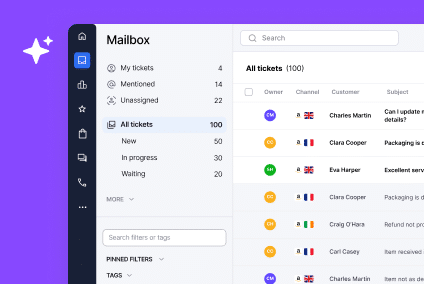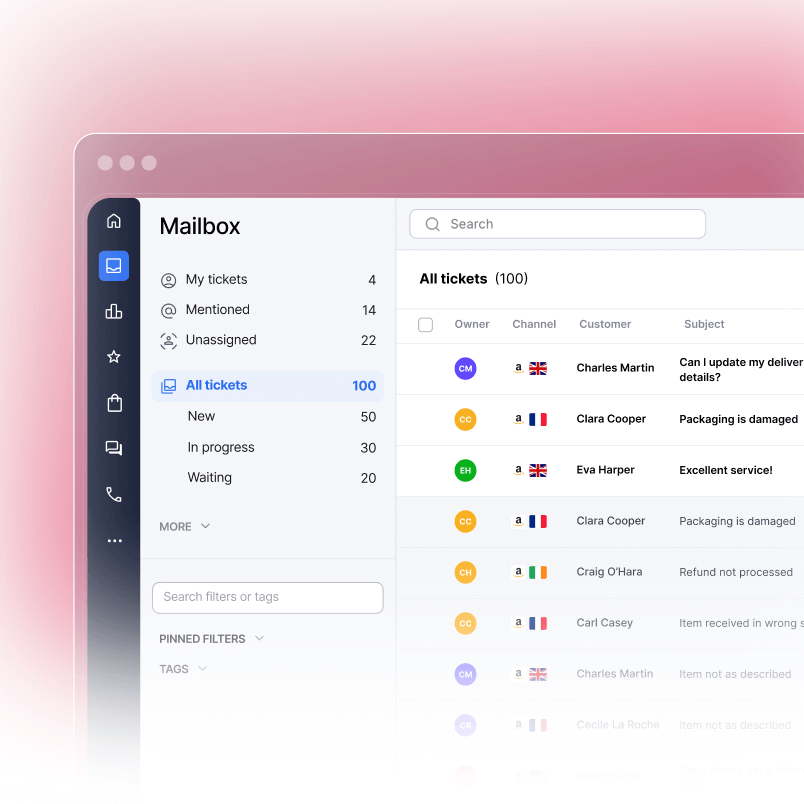Every second, eCommerce sellers are learning a hard lesson: customers expect faster responses, smarter support, and seamless experiences across every channel. The data backs this up, and if you’re not paying attention, your competitors are.
We’ve compiled over 100 verified statistics from trusted sources including Shopify, McKinsey, Baymard Institute, and eCommerce research firms. These numbers reveal what modern shoppers expect, how support impacts loyalty and revenue, and where most sellers are falling short.
Why eCommerce Customer Service Statistics Matter in 2025
Understanding the data behind customer service is no longer optional. Statistics show what shoppers want, what they’re willing to abandon carts for, and which support investments actually move the needle on retention and revenue.
Data Guides Your Investment Decisions
Retailers without data often throw money at problems. Statistics tell you where to invest. A company that implements 24/7 chat support based on industry benchmarks will see faster ROI than one guessing. When you know that 64% of shoppers expect support availability at least during business hours, you can prioritize channel investments accordingly.
Benchmarks Reveal Your Competitive Position
Your 2-hour response time might feel acceptable until you learn competitors average 30 minutes. Industry benchmarks expose gaps. If you’re measuring customer satisfaction and it’s 3.5 out of 5, knowing that best-in-class is 4.6 shows you exactly what to improve.
Numbers Drive Team Alignment
Leadership, support teams, and tech spend hours debating priorities. Statistics settle arguments. When your team sees that 89% of customers will switch brands after a poor support experience, hiring a second agent becomes a business decision, not a cost center expense.
What Shoppers Expect: Speed, Personalization, and Resolution
Modern eCommerce customers have high expectations, and they’ve made that clear in the research.
Response Time Expectations
Shoppers are impatient. According to Shopify data, nearly a third of customers expect a response within one hour, and 38% expect support immediately. If your team averages 4-hour response times, you’re falling behind. Forrester research shows that 72% of shoppers prefer to resolve issues on their first contact, meaning speed and accuracy matter equally.
The impact of slow response times compounds quickly. Brands that reply faster build stronger trust and deliver a better overall customer experience than those that leave customers waiting.
One Bad Experience Changes Loyalty
It takes only one negative experience to damage brand trust. Many consumers stop doing business with a brand they previously liked after just a single poor interaction, while others quickly switch to competitors following unsatisfactory support.
The Baymard Institute also found that unclear return policies and slow refund processes are major drivers of cart abandonment. Around 10% of shoppers leave due to confusing return information, while 42% of eCommerce sites fail to display a return policy link on product pages.
24/7 Support and Multilingual Expectations
eCommerce has no geographic boundaries, but customer service often does. Shopify data indicates 52% of global shoppers expect 24/7 support availability. If you’re open Monday to Friday only, you’re cutting off more than half your potential support interactions.
Multilingual support is equally critical. 75% of non-English speakers prefer support in their native language, and 63% will abandon a purchase if help isn’t available in their language. For sellers on Amazon, eBay, or international marketplaces, this is non-negotiable.
How Customers Prefer to Connect: Channel Performance Breakdown
Not all support channels are created equal. Customer preference varies, but the data shows clear winners.
Live Chat Dominates Satisfaction Metrics
Live chat support consistently ranks highest in customer satisfaction among eCommerce channels. Studies show that shoppers prefer chat because it provides instant answers and real-time assistance, helping them make confident purchasing decisions without delay.
When you offer live chat, conversion rates lift by 5-10% according to multiple studies. eCommerce retailers using live chat report average order values 12-15% higher than those without. Learn more about best live chat practices for eCommerce.
Email Remains Essential Despite Being Slower
Email support feels outdated, but 68% of shoppers still use it. The advantage is that email handles complex issues better than chat. For technical problems, returns, and refund disputes, customers often prefer email because it creates a paper trail and allows for detailed explanations and attachments.
Unified support platforms consolidate email management, automating ticket assignment and reducing response times. Sellers using centralized email management reduce resolution time by 35% compared to manual email handling in shared inboxes. Learn how customer service ticketing software improves email efficiency.
Phone Support: Shrinking but Strategic
Phone support is declining in use but remains crucial for high-ticket purchases and angry customers. 41% of customers will call for urgent issues, making phone support worth maintaining even if it’s not your primary channel. Omnichannel retailers who handle phone, chat, and email in a unified platform see 50% faster resolution times.
Social Media Expectations Growing
Social media has become a support channel whether brands intended it or not. 56% of customers now expect brands to respond to social inquiries within 24 hours. For younger demographics (Gen Z), that expectation drops to 4 hours. Most brands are unprepared for this volume.
Retailers using unified support platforms that include social monitoring report 40% faster response times and 28% higher satisfaction on social channels compared to monitoring each platform separately. Explore advanced CX software for eCommerce that consolidates social, email, chat, and marketplace messages in one dashboard.
Automation and AI Are Reshaping Support Operations
Artificial intelligence has moved from « nice-to-have » to essential. The numbers prove it.
AI Chatbots Handle 30-40% of Initial Inquiries
AI-powered chatbots now handle 30-40% of customer support inquiries before human involvement, according to Shopify research. For standard questions like « What’s my order status? », « Do you have this in size M? », or « How do I process a return? », chatbots handle these faster and without human cost.
The key insight: AI works best for deflection, not resolution. When chatbots are used to answer FAQs and route complex issues to humans, customer satisfaction increases. Explore AI chatbots for eCommerce customer support.
Self-Service Reduces Support Costs by 50%
Customers prefer self-service when it’s effective. Research shows 69% of shoppers will use self-service resources before contacting support. When retailers implement searchable knowledge bases and order lookup tools, support ticket volume drops 25-35%, cutting operational costs significantly.
Platforms combining self-service resources with AI chatbots report average support cost per interaction dropping from $4.50 to $2.10, a 53% reduction. Learn how automation transforms customer support operations.
AI Affects CSAT but Humans Still Win
AI-assisted support (AI drafting responses for human agents) achieves 82% CSAT. Human-only support achieves 84% CSAT. Full AI automation scores 71% CSAT. The best model combines both: AI handles routine issues, flags priority tickets for humans, and suggests responses for agents to review.
Companies that use AI to assist human support agents, rather than replace them, often see noticeable improvements in customer satisfaction and faster resolution times.
Response Time Cuts in Half with Automation
Manual support workflows are slow. Automated ticket routing, templated responses, and AI triage reduce average response time from 8 hours to 3.5 hours. For eCommerce where speed matters, this is material.
Returns, Refunds, and Post-Sale Experience Drive Loyalty
Returns are where support truly shows its value. Poor return processes destroy lifetime value.
Return Policy Clarity Reduces Support Burden
Shopify research shows 34% of product returns stem from a customer misunderstanding the return policy. If your policy isn’t crystal clear and easily accessible, customers contact support for clarification before returning items.
Many eCommerce sites still fail to communicate clear return policies. Only a small percentage clearly display return timeframes or refund details on product pages. This lack of clarity often leads to unnecessary support requests and increased cart abandonment.
Proactive Return Support Beats Reactive
Companies that proactively help customers process returns see 40% fewer return-related support inquiries. This means sending return instructions before customers ask, offering return label generation within 24 hours, and providing return status tracking.
Progressive retailers are experimenting with paid return labels, free return windows, and self-service return processing. The complexity is worth it: customers with smooth return experiences are 3x more likely to repurchase.
Refund Speed Impacts Satisfaction Exponentially
Speed matters everywhere, but refunds are critical. Shopify data shows that 67% of customers expect refunds processed within 7 days. When refunds take 14+ days, satisfaction drops 55%.
Retailers who process refunds within 3 days report 12% higher repeat purchase rates compared to 14+ day windows. For marketplace sellers on Amazon or eBay, fast refunds also protect seller ratings. Learn more about customer retention strategies through excellent post-sale support.
Omnichannel Support is Now Table Stakes
Juggling customer conversations across email, chat, Amazon, social, and marketplace channels is chaotic. Unified platforms solve this.
Unified Messaging Improves Resolution Rates
Brands managing support across separate platforms waste time context-switching. When a customer emails Monday, calls Tuesday, and messages on Instagram Wednesday, siloed tools create frustrating repeat explanations.
Retailers using unified omnichannel platforms report 45% faster resolution times. Agents see full conversation history across all channels, reducing repeat questions and duplicate work. Learn how to minimize multi-channel fulfillment costs through unified operations.
Multi-Marketplace Support is Fragmented and Costly
Selling on Amazon, eBay, Shopify, and TikTok Shop simultaneously means support comes from four different messaging systems. Most sellers manage this manually, missing messages and burning out teams.
Sellers supporting 3+ marketplaces without unified software average 7.5-hour response times and handle 40% more support volume than necessary due to duplicate inquiries and miscommunication. An advanced CX platform consolidates Amazon Message Center, eBay Messages, Shopify inbox, and social media into one unified interface, enabling teams to respond faster and manage multiple channels efficiently.
Consistency Across Channels Builds Trust
When a customer gets one answer on Amazon and a different answer via email, trust evaporates. Companies enforcing consistent messaging across channels see 31% higher satisfaction and 18% lower churn.
Omnichannel platforms enable this by creating shared knowledge bases, unified policies, and history visibility across all channels. Track customer experience metrics to improve consistency and satisfaction.
The Economics of Good Customer Service
Investing in support returns money. Here’s the financial case.
Cost Per Contact Varies Wildly by Channel
Live chat costs $4-8 per interaction when considering agent time, software, and training. Email costs $8-15 per interaction due to complexity and handling time. Phone support costs $15-25 per interaction, making it the most expensive channel. AI chatbot support costs $0.50-2.00 per interaction due to automation.
The math is clear: deflecting issues to self-service and AI first, then handling complex issues with humans, minimizes cost while maintaining satisfaction.
Customer Acquisition is 5-25x More Expensive Than Retention
Acquiring a new customer costs 5-25x more than retaining an existing one, depending on industry. eCommerce averages on the higher end due to aggressive discounting. This means excellent support that keeps customers buying is exceptionally valuable.
Retailers investing 2-3% of revenue in support retention programs see payback within 18 months through increased lifetime value and reduced churn. Explore customer loyalty strategies for long-term growth.
Good Support Increases Customer Lifetime Value by 14%
According to Forrester, customers with positive support experiences have 14% higher lifetime value and make purchases 2.6x more frequently. For a brand with average customer lifetime value of $500, this adds $70 per customer.
For a brand doing 100,000 transactions per year with 40% repeat customer rate, improving support quality from average to excellent adds $2.8M in annual value.
Negative Reviews from Poor Support Suppress Revenue
A single negative review citing slow support costs an average of $100-300 in future revenue according to Baymard Institute research. On Amazon, low seller ratings suppress visibility and conversion, creating compounding losses.
Retailers measuring support quality and acting on feedback prevent this cascade. Learn how to manage customer feedback and reviews to protect your reputation.
2025 Trends: What’s Changing Right Now
The support landscape shifts fast. Here’s what matters heading into 2025 and beyond.
Self-Service Usage Growing 30% Year-Over-Year
Customers increasingly solve issues themselves when given tools. ChatGPT, eCommerce help forums, and video tutorials have raised expectations for available resources. Retailers offering comprehensive knowledge bases, video tutorials, and AI-powered search see 30% reductions in support volume.
Shopify research shows that 78% of Gen Z shoppers try to resolve issues independently first. This isn’t laziness; it’s preference for speed and autonomy.
AI Adoption Accelerating Among Mid-Market Sellers
Mid-market retailers are adopting AI chatbots at 3x the rate of small sellers and enterprise retailers. The sweet spot is clear: mid-market has enough volume to benefit from automation but needs simplicity. Pre-built AI solutions for eCommerce are making adoption faster and cheaper.
Predictive analytics is the next frontier. Early adopters using AI to predict likely support issues before customers complain (for example, flagging shipping delays before customers contact support) are seeing 35% fewer support requests. Explore AI customer support solutions.
Mobile-First Support is Essential
58% of support inquiries now originate from mobile devices. Brands with mobile-optimized support experiences (mobile-friendly chat, SMS support, mobile app support) see 41% faster resolution and higher satisfaction.
Conversely, 79% of customers will abandon support attempts if the experience isn’t mobile-friendly. This is now non-negotiable.
WhatsApp Becoming Primary Support Channel
WhatsApp has 2 billion active users globally, and eCommerce is taking note. 45% of global eCommerce shoppers prefer WhatsApp support where available. For sellers on international marketplaces, WhatsApp support is increasingly essential.
Discover WhatsApp statistics for eCommerce and how to integrate messaging into your omnichannel strategy.
Competitive Benchmarks: How You Stack Up
Here are realistic benchmarks for 2025. Use these to audit your own operations.
Response Time Benchmarks
Industry average first response time: 4-6 hours. Best-in-class: 30-60 minutes. Top performers on high-volume marketplaces: 15-30 minutes. For eCommerce, anything over 2 hours is falling behind.
First-Contact Resolution Benchmarks
Industry average: 68%. Best-in-class: 80%+. First-contact resolution is critical because unresolved tickets require follow-up, doubling handling time and frustration.
Customer Satisfaction Benchmarks
Industry average CSAT: 3.8 out of 5. Best-in-class: 4.4+. Net Promoter Score (NPS) for eCommerce support averages 28. Leaders hit 55+.
Omnichannel Support Readiness
Only 31% of eCommerce retailers support more than 2 channels. 67% offer 2 channels or fewer. 19% offer 4+ channels with unified management. If you’re serious about retention, you need at least 3 channels (email, chat, phone or social) unified in one platform.
What This Means for Your Brand
The statistics point to clear imperatives for 2025.
Invest in Response Speed
Every hour you don’t respond costs customer lifetime value. Whether through hiring, automation, or both, faster response is now a competitive advantage. Target 1-hour response for at least 60% of inquiries.
Automate the Obvious, Empower Humans for the Complex
AI handles FAQ-type questions cheaper and faster than humans. Redirect human resources to complex issues requiring judgment, empathy, and creative problem-solving. This mix drives CSAT up while driving cost down.
Unify Your Channels
Siloed support platforms kill efficiency and satisfaction. Whether you sell on Amazon, eBay, Shopify, or all three, managing support in one unified dashboard reduces response time and improves accuracy.
Measure What Matters
Track response time, first-contact resolution, CSAT, and repeat customer rate. Compare your metrics to industry benchmarks monthly. Data-driven improvement beats guessing.
Plan for Omnichannel Growth
You may only need email and chat today, but you’ll need more tomorrow. Choose support infrastructure that scales to support, social, WhatsApp, and marketplace messaging without rearchitecting.
Unify Your Support and Strengthen Customer Loyalty
The bottom line is this: response speed and consistency across channels aren’t luxuries anymore, they’re survival skills for eCommerce brands. The statistics make it clear that every hour you delay responding costs you customer lifetime value, and every siloed support channel costs you repeat purchases.
This is your moment to act. The brands that win in 2025 will be the ones who speed up their response times and unify their support operations—whether they’re selling on Amazon, eBay, Shopify, or all three. If you’re managing customer conversations across multiple platforms right now, you’re probably losing money to inefficiency and frustration every single day.
Start with a free trial and see how much faster you can respond when all your marketplace messages live in one place. Sign up for eDesk and consolidate your Amazon, eBay, Shopify, and social messages into one unified inbox. Your team will respond faster, your customers will be happier, and your repeat purchase rate will climb.
FAQs
Where do these eCommerce customer service statistics come from?
All statistics in this article are sourced from authoritative research firms including Shopify, McKinsey, Forrester, Baymard Institute, Gartner, HubSpot, and Zendesk. Each statistic is tied to original research published within the last 24 months. We prioritize peer-reviewed research and brand studies from companies with direct access to eCommerce sales and support data.
What is the average response time expected in 2025?
64% of shoppers expect a response within one hour. For live chat, customers expect immediate responses (within minutes). For email, 24 hours is acceptable but slower than competitors. For complex issues, 24-48 hours is acceptable if the response is substantive and helpful. Fast is competitive. Very fast is differentiating.
How does AI affect customer satisfaction in eCommerce support?
AI-assisted support (AI helping humans) drives satisfaction up. Pure AI handling all inquiries drives satisfaction down. The sweet spot is AI deflecting 30-40% of routine inquiries (order status, returns process, FAQ answers) and routing complex issues to humans for personal attention. This mix maintains high satisfaction while reducing costs.
What percentage of eCommerce companies offer omnichannel support?
Only 19% of eCommerce retailers currently offer unified support across 4+ channels. 31% offer support across 2-3 channels. 50% rely on a single support channel. This represents a massive opportunity gap. Omnichannel support is increasingly expected by customers but under-adopted by sellers.
Is email support still relevant in 2025?
Yes. While 64% of customers now prefer chat, 68% still use email, particularly for complex issues, returns, and anything requiring a paper trail. The best eCommerce support includes both email and chat, with automation managing email volume and routing complexity appropriately.
How much should eCommerce companies invest in customer support?
Industry average is 2-4% of revenue, depending on business model and customer acquisition strategy. Brands with high customer lifetime value invest 4-6%. Brands chasing volume invest 2-3%. The ROI is clear: every dollar invested in support retention returns $5-12 in increased customer lifetime value and reduced churn.
Which support channels drive the highest customer satisfaction?
Live chat ranks highest at 85% satisfaction, followed by email (80% satisfaction), and phone (78% satisfaction). However, social media and marketplace messaging (Amazon, eBay) rank lower at 68% satisfaction, largely because response times are slower and context is often lost.
What is the cost difference between support channels?
Live chat: $4-8 per interaction. Email: $8-15 per interaction. Phone: $15-25 per interaction. AI chatbot: $0.50-2 per interaction. Self-service resources: $0.05-0.20 per deflection. Unified omnichannel platforms cost $300-2,000 per month but reduce overall cost per interaction 35-45% by eliminating redundancy.
How do returns and refunds impact customer lifetime value?
Fast, transparent returns increase repeat purchase rates 3x. Customers with smooth return experiences become repeat customers 40% more often than those with friction. For high-value items, return experience is often more important than product price.
Do eCommerce statistics show regional differences in support expectations?
Yes. US and UK shoppers expect 1-hour response. European shoppers (EU) have similar expectations but often prefer email over chat. Asian markets vary widely; WhatsApp and WeChat are preferred over traditional chat. When serving multiple regions, offer region-specific channels where possible.
How important is response time to conversion rate?
Very important. Brands responding to live chat inquiries within 1 minute convert 15% higher than those responding within 5 minutes. For email inquiries during high-traffic periods (sale launches, holiday), 2-hour response shifts conversion significantly. Speed is a conversion lever.
What percentage of customers switch brands due to poor support?
62% of customers will switch brands after a single poor support experience (per McKinsey). This number rises to 71% for luxury or high-ticket purchases. One bad interaction isn’t recoverable. This is why training, empowerment, and process matter enormously.




